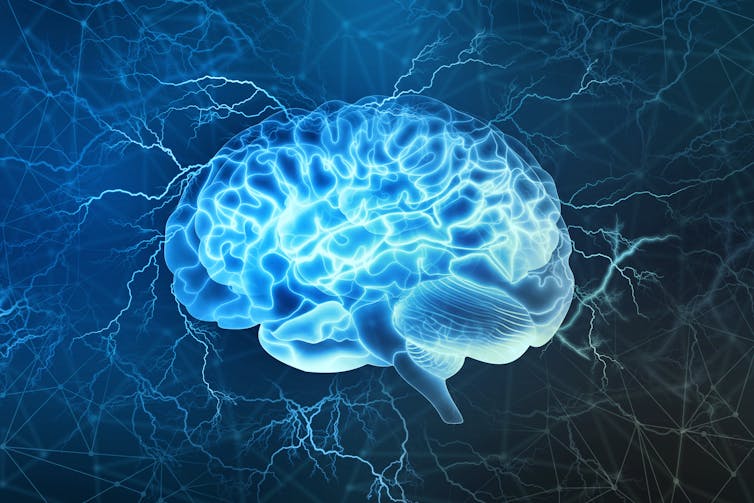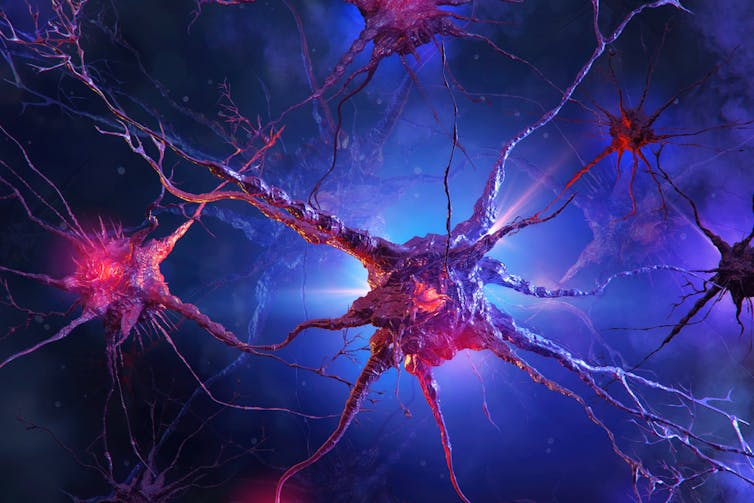
Nancy Brassard, École nationale d’administration publique (ENAP)
Confinement — which has been frequent during the pandemic — has undeniable effects on the brain. There’s the inability to concentrate enough to read or write, the lack of perseverance in tasks, agitation. All this is normal! The brain is not working the way it usually does and it’s being used differently.
An electric current enables the brain to co-ordinate our movements, control our breathing, feel hunger, pain and emotions. This current must circulate properly. The more intense the electrical activity of the brain, the more we will need sleep or feel the effects of lack of sleep. This can affect physical health in many ways, such as weight gain and developing conditions like diabetes and cardiovascular disease. Mental health effects can include behavioural changes, difficulties in concentration and mood swings.
Electrical activity in the brain has long been thought to be related to serious psychological problems. Each brain rhythm has a particular frequency and the brain communicates in five frequency bands (delta, theta, alpha, beta and gamma). Each corresponds to different levels of wakefulness and sleep located in different areas of the brain.
As associate professor at the École nationale d’administration publique since 2009, I recently obtained certificates in neuroscience as well as a graduate diploma in specialized studies in mental health. I study the different variables that influence the competence and expertise of individuals and organizations, as well as mental health issues.
The brain, your powerhouse
The electrical activity of the brain can be measured by placing electrodes on the scalp in different areas. The unit of measurement obtained is a rhythm potential expressed in hertz indicating, by its frequency, the nature of the activity in the measured area. This makes it possible to evaluate the electrical voltage, the speed of propagation, the rhythm and the synchronization of an activity in the brain.

By combining these measures with heart rate and respiration, we can estimate heart rate variability, a non-invasive measure that explores the influence of the autonomic nervous system on the cardiovascular system. Heart rate variability provides an indicator to assess an individual’s ability to cope with stress or to manage stressful situations. This helps explain why two individuals, faced with the same situation, react differently.
When dealing with a difficult event, such as a pandemic, people don’t sleep as well. They become overwhelmed with information by listening to the news more and by constantly talking about the same event and its consequences. They activate more of the neurons responsible for the emotions that are at the heart of the brain. More stress is placed on the frontal and temporal lobes and electrical activity increases in these areas.
The observed effects of this include trouble concentrating or persevering in tasks that require reflection, and problems mustering the motivation to undertake demanding actions
In addition, the hormones responsible for mood and joy are likely less stressed in times of crisis. The things that give us pleasure and generate, among other things, serotonin and dopamine are also less frequent. For some, situations that decrease or disorder these hormones or neurotransmitters may be multiplied or intensified, altering the transmission of information between neurons.
Neurotransmission
Serotonin is involved in several behaviours and abilities, including body heat control, eating and sexual behaviours, sleep management and anxiety. Dopamine is especially linked to cognition, motor functions, motivation, sleep and memory.
When these neurotransmitters are “disturbed” by increased electrical activity in the brain, these behaviours and abilities are altered as well.

It is normal to feel more agitated during this disruption, or to not act as effectively as usual. Consequently, compensation or defence mechanisms may develop. Some will make lists or take on tasks that require less thought or concentration (cleaning, cooking). Others will consume more substances that promote the production of dopamine or serotonin (tobacco, alcohol, coffee, sugar). They will seek comfort (baking bread) and pleasure (running) to feel better or less restless.
This management of emotions also has an impact on the functioning of the immune system, which is responsible for the body’s defence against external aggressions. Some studies show that when an individual experiences negative emotions, their immune system weakens, diminishing its ability to protect the body against these attacks. Therefore, the more positively we manage our emotions, the more our immune system is favoured, which is very useful in times of pandemic.
The question is whether we can improve this variability and influence the efficiency of the brain’s electrical activity. There is a way to recover your faculties and capacities.
Self-regulation or ‘big belly, little belly, 5-5’
What does “big belly, little belly, 5-5” mean? It is a playful version of the practice of cardio-respiratory coherence (CRC), often wrongly called cardiac coherence.
CRC is a research-backed technique to help people control emotions or manage mental health problems such as anxiety and depression, or to quit smoking, lose weight or just relax.
CRC is performed by taking a deep breath for five seconds, until the belly swells (hence the expression “big belly, little belly, 5-5”). This activates the sympathetic branch of the nervous system, the one that provides energy to flee from a threat.
Exhale after five seconds to stimulate the parasympathetic branch, which takes care of rest and the restoration of our system.
For relaxation, perform the same action but breathe in deeply for four seconds and breathe out for six seconds, which will further promote rest and restoration.
CRC can help us better manage our emotions. It allows the heart and lungs to generate a frequency of electrical activity corresponding to relaxation (10-12 hertz), and to initiate the rest and restoration process necessary to restore balance to the autonomic nervous system and, ultimately, to send a message to the brain that “everything is fine!”
Some studies show that after applying this technique for three to five minutes, the level of dehydroepiandrosterone (DHEA, a natural hormone produced from cholesterol by the adrenal glands) increases, and is a precursor to the synthesis of hormones such as testosterone, estrogen and progesterone.
Only recently have technological advances have allowed us to study the brains and human capacities of individuals during their lifetime. It would be normal to feel exhausted after a crisis. It is a good bet that our society will suffer such an impact after the current crisis. So, go ahead … breathe!
Nancy Brassard, Professeur chercheur agrégé docimologue (D.Ba), École nationale d’administration publique (ENAP)


